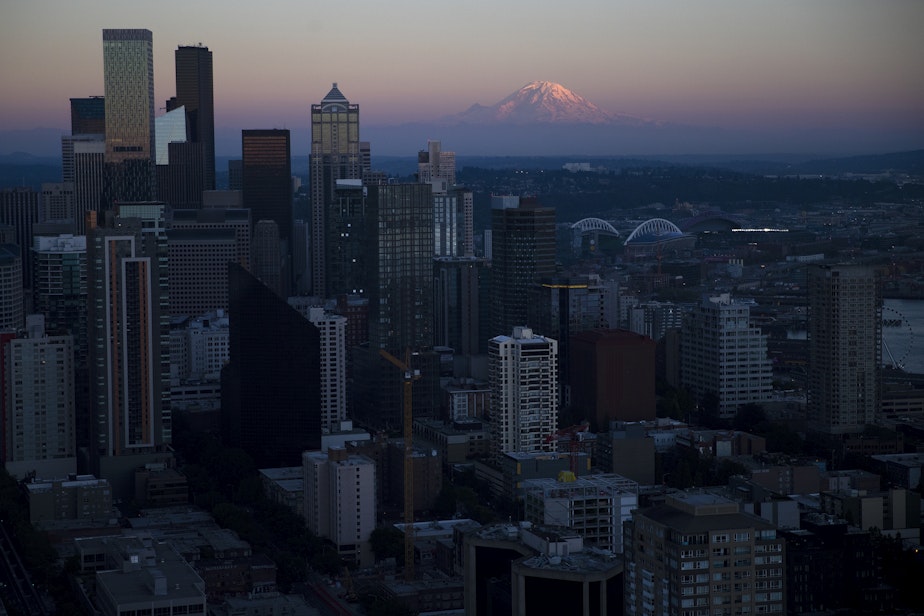Harrell promises downtown fix, but offers few details

Can downtown Seattle be fixed without raising taxes?
Business leaders want it. Mayor Harrell has promised to do it. But his plans on what to do and how to pay for those changes remain murky at best.
T
he mood in the convention center's new Summit building was part delight at the new building, an architectural wonder of layered spaces and sweeping views, and part grim resolve to face the city's problems while enjoying a glass of wine.
And then Downtown Seattle Association CEO Jon Scholes hit the 1,200 business and city leaders in attendance with some hard facts.
Every reporter at the media tables on the sideline (no wine there) reached for their camera phones when Scholes put up a slide showing that between 2020 and 2022, Seattle has lost more people to overdoses (of which an increasing number are due to fentanyl) than from Covid-19.
“We can have a revitalized thriving downtown with retail and restaurants and arts and culture, or we can have a fentanyl market," he said. "We can’t have both.”
Hotel stays are down 25% since 2019. Office workers, by far the most economically important contributors to downtown's street-level businesses, are barely there. About 44% have returned three out of five days a week. That's 26% of the office worker presence downtown Seattle used to enjoy.
Sponsored
Scholes said we need to build a lot more housing downtown, but even the 17,000 residents expected to move into new apartments in the next few years would barely make a dent in restoring the money that flowed in from the 340,000 office workers who used to commute downtown every weekday.
In order to keep that money flowing, Scholes recommended the mayor do four things:
- Make the streets healthy and welcoming for all.
- Get people back to offices.
- Make downtown the easiest option – the best place to open a new business.
- And, "Do no harm," which is code for, "Do all these things without raising taxes on businesses."
In a way, the mayor has promised to do exactly this. And in his speech to the assembled power brokers (who he jokingly referred to as "potential donors"), he promised that his downtown revitalization plan was going to be great.
“We know exactly in the Harrell administration what we want downtown to look like," he told the crowd. "We researched; we looked around the world at other cities. I can tell you chapter and verse what this downtown is gonna look like.”
Sponsored
But Mayor Harrell didn't provide a lot of details. He hinted that his plan would include more day cares, more places to live, more artist performance spaces, and more street-level businesses like you’d see at the Pike Place Market. But he said he can’t reveal any granular details for another four to six weeks.
"Bear with me," he said.
Harrell said he has to get the political support and funding lined up, so that his solutions are sustainable.
He’s going to have to get the city council to agree to change some laws, he said. It's unclear what that means at this point. During his State of the City speech last month, Harrell promised an executive order on fentanyl. But an executive order doesn't necessarily require the changing of laws, so it's unclear what he has in mind.
Meanwhile to the north in Bellingham, Mayor Seth Fleetwood has faced some skepticism about his plan to outlaw public drug use and redirect users to a "therapeutic court" that doesn't yet exist. Come back when you have more details, Bellingham's City Council told Fleetwood Monday, according to The Bellingham Herald. In Seattle, such an approach would likely meet similar if not stronger skepticism.
Sponsored
Also, Mayor Harrell is going to need money. He said the city has a $140 million budget deficit. Given that, he would need private money to fund his downtown reforms from some of the same people in the convention center room who sipped their wine as he spoke.
“I have limited funds, and I don’t think you want me to be that tax, tax, tax, tax, tax, person who drives business away," he said. "I came in on a platform of a strong business environment, strong public safety. So, I will take my hits on being vague for a few more weeks until I figure this out, because I have a talented, committed administration, and we are bold, and we love this city, and we are reclaiming this city.”
When facing a challenge, Harrell turns to football analogies, inspired by his time as a linebacker tackling the offense (and setting records doing it). Fixing downtown is one of those challenges he has his eyes set on. He’s like a linebacker looking at a cocky quarterback.
Harrell wants to take that problem down. He wants to accomplish a lot. But he doesn’t have enough money to do it.
Right now, he’s banking on the creativity of his staff to do a lot without a lot of money. These include bureaucrats who, in another administration, might get to air their big ideas in meetings but never see those big ideas get taken seriously.
When Harrell talks about the future, he seems to be offering his staff more. "This is our time to redefine the city," he said Tuesday.
In the Office of Planning and Community Development, for example, there is real optimism about the future. But you can’t do all this stuff on enthusiasm alone. You need tax money or private donations.




